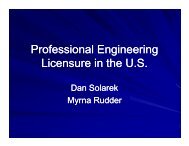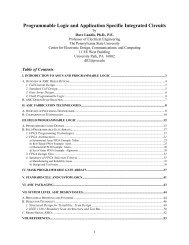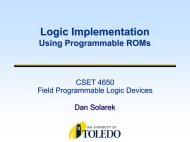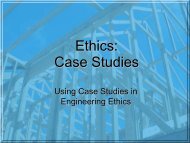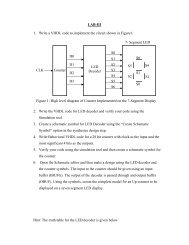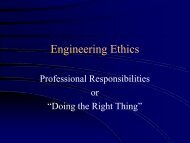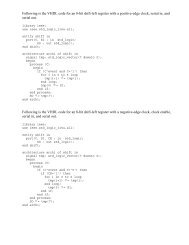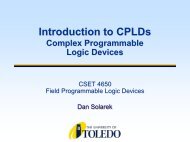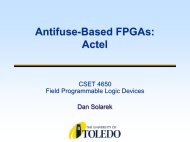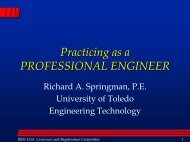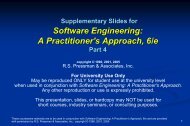CSET 1100 Unix and C - The University of Toledo - Engineering ...
CSET 1100 Unix and C - The University of Toledo - Engineering ...
CSET 1100 Unix and C - The University of Toledo - Engineering ...
You also want an ePaper? Increase the reach of your titles
YUMPU automatically turns print PDFs into web optimized ePapers that Google loves.
Syllabus: <strong>CSET</strong> <strong>1100</strong><br />
Course Objectives:<br />
After successful completion <strong>of</strong> this course, students will be able to:<br />
• Describe the fundamentals <strong>of</strong> computer history, hardware, s<strong>of</strong>tware <strong>and</strong> OS.<br />
• Connect from a remote location to a UNIX server on which they have an established shell<br />
account.<br />
• Transfer files to <strong>and</strong> from a PC to their account on a UNIX server.<br />
• Use the UNIX man pages to determine the proper syntax for user-level UNIX comm<strong>and</strong>s.<br />
• Manage their file system on a UNIX server.<br />
• Create technical programs using the C programming language.<br />
• Debug <strong>and</strong> test program.<br />
• Describe <strong>and</strong> implement the data structures available in the C programming language.<br />
• Design simple algorithm using pseudocode.<br />
• Create programs that implement a variety <strong>of</strong> common algorithms using the C<br />
programming language.<br />
Major Topics Covered in the Course<br />
Topic CC2001 CC2001<br />
Category Core<br />
History <strong>of</strong> Computing SP1 1.0<br />
Overview <strong>of</strong> OS (<strong>Unix</strong> as example) OS1, NC1 1.5<br />
Introduction to net centric computing (FTP,SSH etc) OS1, NC1 1.5<br />
Machine level representation <strong>of</strong> data AR2 1.5<br />
Assembly level machine organization AR3 1.5<br />
Overview <strong>of</strong> Programming Languages PL1 1.5<br />
Procedure Development:<br />
Pseudocode, Flowcharting & Control Structures<br />
PF2 1.5<br />
<strong>The</strong> process <strong>and</strong> mechanism <strong>of</strong> creating a program SE1 1.5<br />
Program environment, tools SE3 1.5<br />
Intro to C: Basic Programming structure PF1 1.5<br />
Basic Syntax, Variable declaration, I/O PF1, PL4 1.5<br />
Basic Operators, Expression evaluation, Priority,casting PF1 1.5<br />
Introduction to the gcc for compiling C program code PL3 1.5<br />
Block statement, C Flow Control: Branching PF1 1.5<br />
Looping, break, continue, sentinel PF1 1.5<br />
Abbreviations, Characters conversion PF1 1.5<br />
Debugging <strong>and</strong> testing, error <strong>and</strong> h<strong>and</strong>ling SE3 1.5<br />
Library, Function PF1 1.5<br />
Scope <strong>of</strong> variables, parameter passing PF1 1.5<br />
One-Dimensional Arrays, searching, summing, etc. PF3 1.5<br />
String <strong>and</strong> operations PF3 1.5<br />
Properties <strong>of</strong> good s<strong>of</strong>tware design SE1 1.5<br />
Higher-Dimensional Arrays PF3 1.5<br />
Typedef, structures PF3 1.5<br />
Text File Processing PF1 1.5<br />
S<strong>of</strong>tware requirements, validation <strong>and</strong> verification SE5, SE6 1.5<br />
CC2001<br />
Advanced




